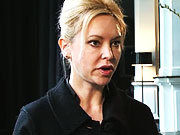Armstrong: Living architecture - example of Venice
The city of Venice seemed to be a perfect thought experiment for an exploration of the potential of the new technologies that we're developing and how to articulate what these technologies might do that traditional technologies haven't managed to achieve. Venice was a city that was threatened by the changes in water level. Obviously it's a very complex situation. But we were very interested in its relationship with water, because many of the technologies we're using are actually dependent on water for their movement, for their metabolism and for the energy that exists at the interface, which is between oil and water. And so its historic context as well and the fact that it represents all of these wonderful things that humans do and that it was something that was worth preserving, but twentieth century techniques haven't managed to come up with a strategy that everybody really likes and it still remains a huge problem in terms of what we're going to do with Venice. So we decided to undergo a thought experiment. Would it be possible for us to design protocells in a way that could help us breathe new life into Venice in some way? Or create strategies through which the city of Venice could be transformed so it was more equipped to deal with the challenges that it’s currently facing?
So what we did was, we designed a system that was based on observations that we'd made in the laboratory. So we know that the protocells can move away from light. We can design them to do that. We also know that they can produce carbonate shells, which is the experiment that I've been involved in. And so we combined these features, so that if we selectively introduced the protocells into the canals in Venice, then the idea was that they don't like the light, they don't deposit their solid material in the open canals, but they go down under the foundations of Venice where it's dark, they reach a lower energetic state, and they're able to secrete these carbonate shells around the droplets and they gradually petrify or create a coral reef around the foundations of Venice.
Now, what this does from an architectural perspective, is it literally takes the stilettos of the city and turns them into platform boots. So it spreads the point load. Because Venice is built in a very soft base. And so by off-loading some of the weight of the city, we would be able to attenuate some of the sinking.
But the speculative use of the technology also provided a very interesting way of articulating the way that we would engage with the technology. So, for example, we'd use it in very specific contexts, where buildings would be threatened, and that we would be able to monitor and garden, as it were, the progression of the reef-like structure underneath the city of Venice and we'd be hoping that we would encourage the marine ecology to actually participate in this. Because of course by creating an artificial reef, you create new homes and shelters for the marine wildlife. We thought it was a very interesting way of articulating how we can create an architecture that connects the natural system to an existing city. And that the growth and development of this reef would become like an underwater park or feature that would actually add an additional benefit that wouldn't destroy the way that Venice already looks and is the place that we love and know and think about romantic encounters and places of great beauty. But it doesn't spoil that aesthetic, but at the same time it brings in another dimension that is not yet viewed. And perhaps this then brings alternative business into the city and creates a feature that becomes part of the whole Venice experience.
So, really, it was a thought experiment, but also has a very practical basis and of course this is something that we're looking to develop models for and start to test the technology. Because, again, because it's based on a complex system, it's something that really needs to be set up and designed and tested. It's very hard to predict exactly what's going to happen. And we already appreciate that there are things like local currents, populations of fish that might find little fatty droplets very tasty. There are lots of challenges of course, introducing a complex agent into a complex environment, that would really need this kind of gardening engagement. But we think that's part of the beauty of the technology as well.

